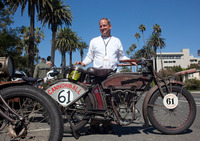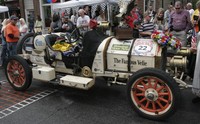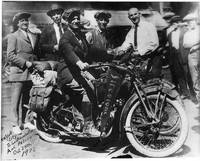 This post was already decided upon. It was already partially written. An unusually epic tale befitting an epic journey whereupon a few adventurers travel on two wheels to the frontier region of Labrador, Canada, and brave unpaved roads and wild animals while risking the potential failure of their machines. Man vs the elements, off the beaten path, etc, etc, etc. Done.
This post was already decided upon. It was already partially written. An unusually epic tale befitting an epic journey whereupon a few adventurers travel on two wheels to the frontier region of Labrador, Canada, and brave unpaved roads and wild animals while risking the potential failure of their machines. Man vs the elements, off the beaten path, etc, etc, etc. Done.
And then I returned and began to get caught up on some reading. That changed everything. It is still probable that the tale will make its’ way to this blog at some future point, but not now. The reason is because of three separate articles in different publications that seemed to conspire to render recent travels in a different light. The first article was on the recent Motorcycle Cannonball endurance run. For those not familiar, this is a coast-to-coast run for machines produced at least 95 years ago. The machine must have an original engine and only basic concessions for safety are allowed. The 2010 edition was from North Carolina to California, and accordingly featured machines from 1915 or earlier. The winner was Brad Wilmarth on his 1913 Excelsior. He had a couple of issues along the way but basically rode a 95-year-old motorcycle 3000 miles on B roads, over mountains, plains, etc.
 The second article was on the 2011 Great Race. Coker Tire and Hemmings motor news have revived this event first held in 1983. It was initially a race for Pre-WWII cars and always covered some large pieces of the USA such as LA to Indianapolis, or San Diego to Orlando. This year’s event was from Coker HQ in Chatanooga, TN to Hemmings HQ in Bennington, VT. It allowed any car 1969 or older, which is a heck of a spectrum, but there are significant weighting factors for the age of the vehicle to even things out. The race was won by….wait for it…a 1911 Velie Racetype, which happened to be the oldest vehicle in the race at 100 years old! While it is true that there are support crews at the nightly stops, there has always been a fair amount of attrition. Those of us concerned about driving a 1970s car with a trunk full of spares more than a few hundred miles are clearly not yet worthy…
The second article was on the 2011 Great Race. Coker Tire and Hemmings motor news have revived this event first held in 1983. It was initially a race for Pre-WWII cars and always covered some large pieces of the USA such as LA to Indianapolis, or San Diego to Orlando. This year’s event was from Coker HQ in Chatanooga, TN to Hemmings HQ in Bennington, VT. It allowed any car 1969 or older, which is a heck of a spectrum, but there are significant weighting factors for the age of the vehicle to even things out. The race was won by….wait for it…a 1911 Velie Racetype, which happened to be the oldest vehicle in the race at 100 years old! While it is true that there are support crews at the nightly stops, there has always been a fair amount of attrition. Those of us concerned about driving a 1970s car with a trunk full of spares more than a few hundred miles are clearly not yet worthy…
 However, both of these prior events are well supported with crews and sag wagons, and while you are certainly risking a mishap and or your safety, you are more likely than not to reach your destination each day. The piece de resistance was an excerpt from the diary of J.T. Hart that was published in Backroads magazine. It partially chronicles a trip by four friends from Pennsylvania to Oregon, on four Indian motorcycles, in 1922. Ironically, last year I traveled between the same two states to the BMWMOA rally. But their journey was slightly different. Hart describes (in an unremarkable matter-of-fact way), weather problems, roads washed out, lack of roads, bike problems, ingenuity, hospitality, hostile territory, riding all day in a single gear, multiple daily falls, etc. The journal contains statements like “…..a distance of 140 miles…nearly all of the road being sand”, and ” without any trouble except…a puncture….a nice spill on a sharp turn…machine skidded from under him”. The calmness of the prose suggests that this was just a diary rather than a big adventure of some kind. It turns out that quite q few folks were prone to go cross country in 1922 as the photo suggests..
However, both of these prior events are well supported with crews and sag wagons, and while you are certainly risking a mishap and or your safety, you are more likely than not to reach your destination each day. The piece de resistance was an excerpt from the diary of J.T. Hart that was published in Backroads magazine. It partially chronicles a trip by four friends from Pennsylvania to Oregon, on four Indian motorcycles, in 1922. Ironically, last year I traveled between the same two states to the BMWMOA rally. But their journey was slightly different. Hart describes (in an unremarkable matter-of-fact way), weather problems, roads washed out, lack of roads, bike problems, ingenuity, hospitality, hostile territory, riding all day in a single gear, multiple daily falls, etc. The journal contains statements like “…..a distance of 140 miles…nearly all of the road being sand”, and ” without any trouble except…a puncture….a nice spill on a sharp turn…machine skidded from under him”. The calmness of the prose suggests that this was just a diary rather than a big adventure of some kind. It turns out that quite q few folks were prone to go cross country in 1922 as the photo suggests..
So you see now why a trip to Labrador on a modern BMW is the relative equivalent of a trip to the supermarket. That’ll teach me to get caught up on reading….
Dear Wayne:
And yet, there have been plenty of trips when the most modern of machinery, backed by the most thoroughly supplied SAG crews, get bogged down in unforeseen circumstances and get stranded, or are forced to turn around. I am resoonablt certain there isn't anything like an oxygen sensor on the Fabulous "Velie."
Fondest regards,
Jack/Reep
Twiated Roads
Loved your July 2nd blog. Would you consider letting us use it in our Thoughts From the Road article?
Yes indeed, we are a spoiled bunch of kids aren't we ! And those vehicles had suicide shifters, spark arrestors, and other controls that made operating them more complicated than putting it in drive and stepping on the gas. Well said.
Dear Jack,
You are absotively correct. In many ways, we may be just as vulnerable to failure these days for different reasons. A big difference is that you can't sputter into say Backwater MN, and effect a repair using only your noggin, the local Blacksmith, and the general store. Perhaps it is why some of us prefer old iron….Cheers
Brian, no problem, use it as you like. Thanks for your comment.
Dear Mickleton,
Great point. I wrote a post a while back on a visit to the Solvang Museum in CA, where I concluded that people of that time had more arms and legs than we do today. Or, they were at least more coordinated 🙂 Cheers.
Wayne, makes you feel like a wimp huh? I would just watch long way round again to feel better. Camera crew, doctor, chase vehicle, office in london, unlimited funds, personal trainers, etc. Then write your post, I wanna read it!
Dear Propper, your glass is always 1/2 full…….now finish your beer 😉